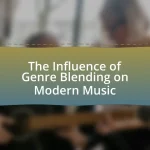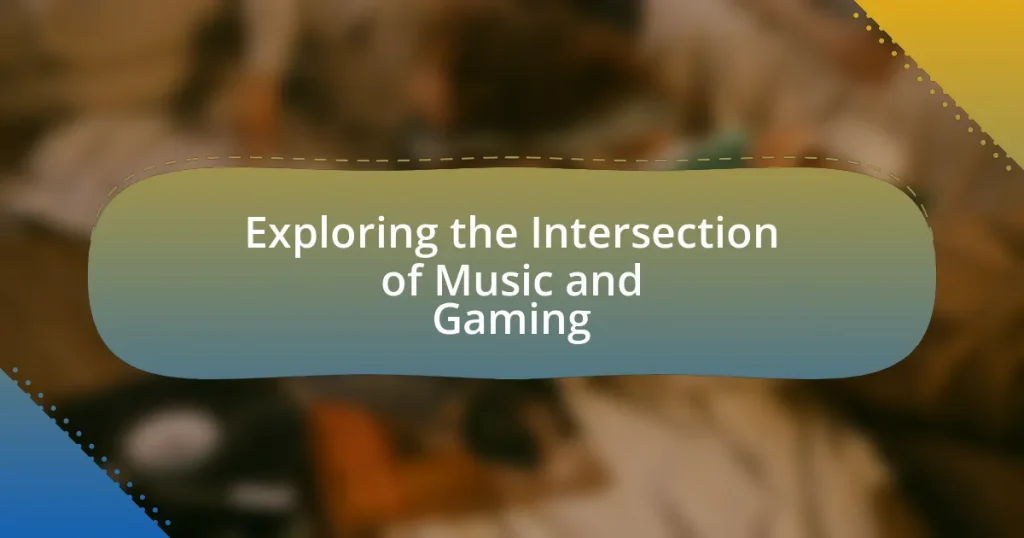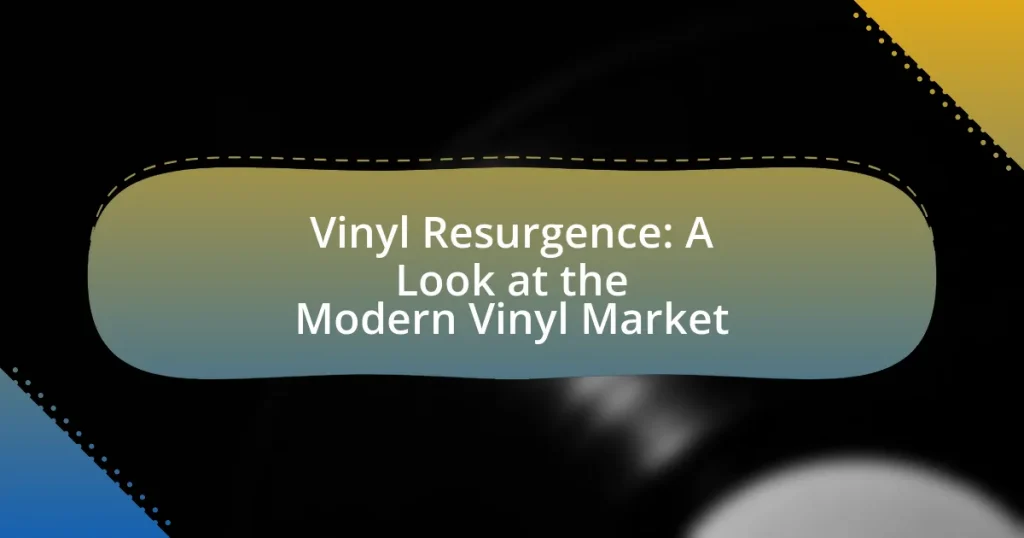The article explores the intersection of music and gaming, highlighting how musical elements enhance the gaming experience through soundtracks, sound effects, and interactive music. It traces the evolution of music in video games from simple synthesized sounds in early arcade games to complex orchestral scores and rhythm-based gameplay. Key historical milestones, technological advancements, and the psychological effects of music on player immersion and engagement are discussed, along with the influence of various music genres on game design. The article also addresses the challenges of licensing and copyright, best practices for integrating music, and future trends in the synergy between music and gaming.
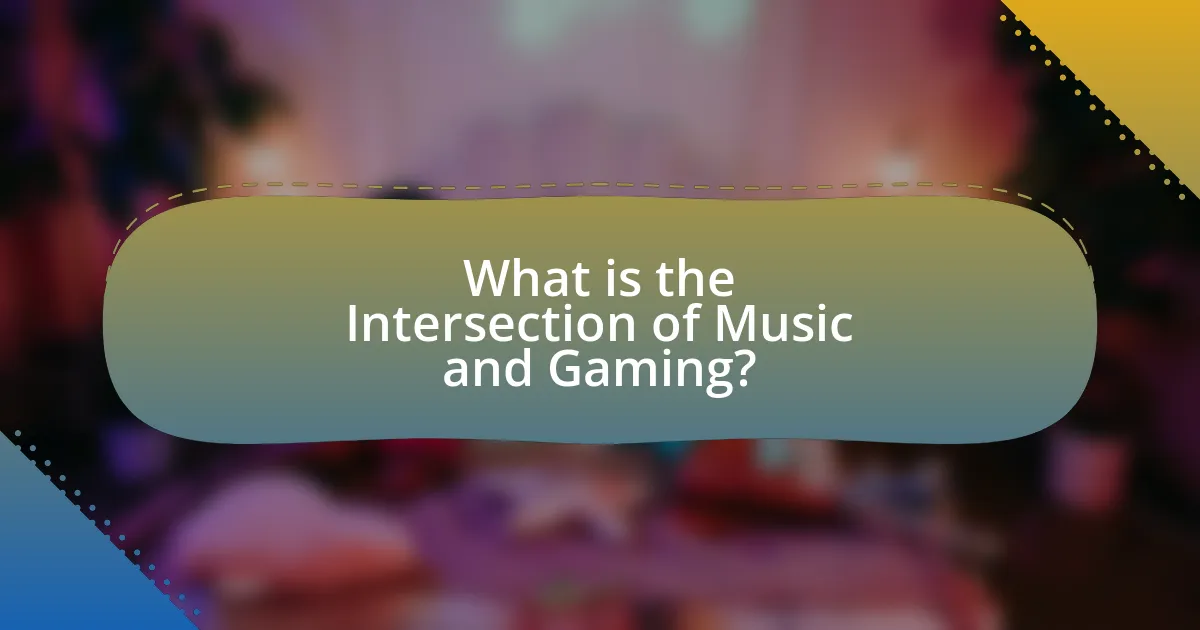
What is the Intersection of Music and Gaming?
The intersection of music and gaming refers to the integration of musical elements within video games, enhancing the overall gaming experience. This relationship manifests through soundtracks, sound effects, and interactive music that respond to player actions, creating an immersive environment. For instance, games like “The Legend of Zelda” and “Final Fantasy” are renowned for their iconic scores, which contribute significantly to their storytelling and emotional impact. Additionally, the rise of rhythm-based games, such as “Beat Saber,” exemplifies how gameplay mechanics can be directly tied to music, further blurring the lines between the two mediums. This synergy not only enriches gameplay but also fosters a unique cultural phenomenon where music and gaming communities converge.
How have music and gaming evolved together over time?
Music and gaming have evolved together through the integration of soundtracks, interactive music experiences, and technological advancements. Initially, video games featured simple, synthesized sound effects and melodies, as seen in early arcade games like Pong in the 1970s. As technology progressed, the 1980s introduced more complex compositions, with titles like Super Mario Bros. featuring memorable themes that enhanced gameplay.
In the 1990s, the rise of CD-ROMs allowed for full orchestral scores, exemplified by games like Final Fantasy VII, which showcased the emotional depth music could add to storytelling. The 2000s saw the emergence of rhythm games, such as Guitar Hero and Dance Dance Revolution, where music became a central gameplay mechanic, further blurring the lines between gaming and music.
Today, the collaboration between musicians and game developers is commonplace, with artists creating original tracks for games and soundtracks being released as standalone albums. The advent of streaming services and platforms like Twitch has also allowed gamers to share their musical experiences in real-time, creating a community around both music and gaming. This ongoing evolution highlights the symbiotic relationship between the two mediums, as they continue to influence and enhance each other.
What historical milestones mark the relationship between music and gaming?
The relationship between music and gaming has been marked by several historical milestones, including the introduction of synthesized music in early arcade games like “Pong” in 1972, which showcased the potential of electronic sound in gaming. In 1985, “Super Mario Bros.” revolutionized video game music with its iconic score composed by Koji Kondo, demonstrating how music could enhance gameplay and emotional engagement. The 1990s saw the rise of CD-ROM technology, allowing for high-quality audio tracks in games like “Final Fantasy VII,” which featured a full orchestral score and became a benchmark for music in gaming. The early 2000s introduced rhythm games such as “Guitar Hero” and “Dance Dance Revolution,” which integrated music as a core gameplay mechanic, further solidifying the connection between the two mediums. In recent years, the emergence of live orchestral performances of video game music, such as the “The Legend of Zelda: Symphony of the Goddesses,” has highlighted the cultural significance of video game music, bridging the gap between gaming and traditional music audiences.
How has technology influenced the integration of music in games?
Technology has significantly influenced the integration of music in games by enabling dynamic soundscapes and interactive audio experiences. Advances in audio technology, such as spatial audio and adaptive music systems, allow soundtracks to respond to gameplay in real-time, enhancing immersion. For instance, games like “The Last of Us Part II” utilize adaptive music that changes based on player actions, creating a more engaging experience. Additionally, the development of digital audio workstations and middleware tools like FMOD and Wwise has streamlined the process for composers and sound designers, allowing for more complex and layered musical compositions tailored to specific game environments. This evolution in technology has transformed how music is composed, implemented, and experienced in gaming, making it an integral part of the overall narrative and gameplay.
What role does music play in enhancing the gaming experience?
Music plays a crucial role in enhancing the gaming experience by creating emotional engagement and setting the atmosphere. It influences players’ moods, heightens tension during critical moments, and reinforces narrative elements, making the gameplay more immersive. For instance, a study published in the journal “Computers in Human Behavior” by researchers from the University of Southern California found that background music significantly increases players’ emotional responses and enjoyment levels. This demonstrates that well-composed soundtracks can elevate the overall gaming experience by aligning with gameplay dynamics and enhancing player immersion.
How does music affect player immersion and engagement?
Music significantly enhances player immersion and engagement by creating an emotional atmosphere that aligns with gameplay. The presence of music can evoke specific feelings, such as excitement or tension, which deepens the player’s connection to the game world. Research indicates that background music can increase players’ emotional responses and improve their overall gaming experience. For instance, a study published in the journal “Computers in Human Behavior” found that players exposed to thematic music reported higher levels of enjoyment and immersion compared to those who played in silence. This demonstrates that music not only enriches the narrative but also reinforces the player’s emotional investment, ultimately leading to a more engaging gaming experience.
What psychological effects does music have on gamers?
Music significantly influences gamers’ psychological states by enhancing immersion, improving mood, and increasing motivation. Research indicates that background music can elevate emotional responses during gameplay, leading to a more engaging experience. For instance, a study published in the Journal of Experimental Psychology found that players exposed to music while gaming reported higher levels of enjoyment and satisfaction compared to those who played in silence. Additionally, music can serve as a motivational tool, helping gamers maintain focus and energy during prolonged sessions, as evidenced by findings from the International Journal of Human-Computer Interaction, which highlighted that rhythmic music can enhance performance and reduce perceived effort.
What are the different genres of music commonly found in gaming?
The different genres of music commonly found in gaming include orchestral, electronic, rock, hip-hop, and ambient music. Orchestral music is often used in epic adventure and role-playing games to enhance the narrative experience, while electronic music is prevalent in rhythm and racing games, providing an energetic backdrop. Rock music frequently accompanies action and sports games, adding intensity, and hip-hop is often featured in urban-themed games, reflecting cultural elements. Ambient music is utilized in exploration and puzzle games to create immersive atmospheres. These genres are integral to gameplay, influencing player emotions and engagement, as evidenced by the success of soundtracks in titles like “The Legend of Zelda” and “Final Fantasy,” which have received critical acclaim for their musical compositions.
How do various music genres influence game design?
Various music genres significantly influence game design by shaping the emotional tone, pacing, and player engagement within a game. For instance, orchestral music often enhances epic narratives in role-playing games, creating a sense of grandeur and immersion, as seen in titles like “The Elder Scrolls V: Skyrim.” In contrast, electronic music can drive fast-paced action in racing or shooter games, providing an adrenaline rush that aligns with gameplay dynamics, exemplified by “Need for Speed” series. Additionally, genres like ambient music contribute to atmospheric exploration in games such as “Journey,” where soundscapes enhance the player’s emotional experience. These genre-specific applications demonstrate how music not only complements but also actively shapes gameplay mechanics and player experiences.
What are the most popular music styles in video games today?
The most popular music styles in video games today include orchestral, electronic, rock, and hip-hop. Orchestral music is frequently used in AAA titles to enhance storytelling and emotional depth, as seen in games like “The Last of Us” and “Final Fantasy.” Electronic music dominates in indie games and rhythm-based titles, exemplified by “Beat Saber” and “Hyper Light Drifter.” Rock music often features in action and adventure games, with franchises like “Guitar Hero” and “Tony Hawk’s Pro Skater” showcasing this style. Hip-hop has gained traction in games like “NBA 2K” and “Fortnite,” where it complements the urban aesthetic and culture. These styles reflect current trends in gaming and player preferences, making them integral to the gaming experience.
How do game developers choose music for their titles?
Game developers choose music for their titles by considering the game’s theme, emotional tone, and gameplay mechanics. They often collaborate with composers to create original scores that enhance the player’s experience and immersion. For instance, a horror game may utilize dissonant sounds to evoke fear, while an adventure game might feature uplifting melodies to inspire exploration. Additionally, developers may analyze player feedback and industry trends to select music that resonates with their target audience, ensuring that the soundtrack complements the overall narrative and enhances engagement.
What factors influence the selection of music in games?
The selection of music in games is influenced by factors such as the game’s genre, narrative context, emotional tone, and target audience. Game developers choose music that aligns with the gameplay experience; for instance, action games often feature fast-paced, energetic tracks to enhance excitement, while role-playing games may use orchestral scores to deepen immersion in the story. Additionally, the emotional tone of a scene dictates music selection, as a tense moment may require suspenseful music, while a joyful scene might use uplifting melodies. Furthermore, understanding the target audience’s preferences can guide music choices, ensuring that the soundtrack resonates with players. Research indicates that music can significantly affect player engagement and emotional response, reinforcing the importance of these factors in the selection process.
How do licensing and copyright issues affect music choices in gaming?
Licensing and copyright issues significantly restrict music choices in gaming by imposing legal limitations on the use of copyrighted material. Game developers must secure licenses for any music they wish to include, which can be costly and time-consuming. For instance, the video game industry generated over $159 billion in revenue in 2020, yet many developers opt for original compositions or royalty-free music to avoid the complexities and expenses associated with licensing popular tracks. This necessity for licensing can lead to a reliance on less recognizable music, impacting the overall player experience and emotional engagement with the game.
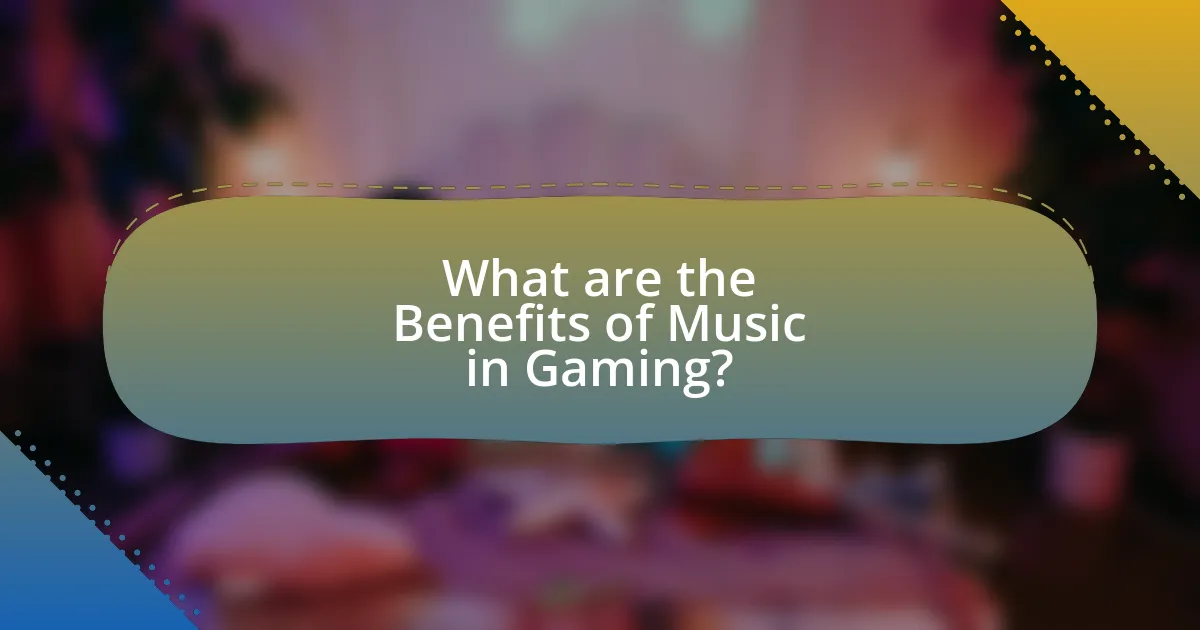
What are the Benefits of Music in Gaming?
Music in gaming enhances player experience by creating emotional engagement, improving immersion, and influencing gameplay dynamics. Research indicates that music can evoke specific emotions, which can lead to increased player satisfaction and motivation. For instance, a study published in the journal “Computers in Human Behavior” found that background music significantly improved players’ emotional responses and overall enjoyment during gameplay. Additionally, music can serve as a cue for in-game events, helping players anticipate actions and react accordingly, thereby enhancing strategic decision-making.
How does music contribute to storytelling in games?
Music enhances storytelling in games by creating emotional depth and atmosphere, guiding player experiences and reactions. For instance, dynamic soundtracks adapt to gameplay, reflecting character emotions and narrative developments, which can intensify moments of tension or joy. Research by the University of Southern California found that players reported a stronger emotional connection to characters when accompanied by music that matched the narrative context. This demonstrates that music not only supports but also enriches the storytelling process in games, making it a crucial element in engaging players and conveying complex narratives.
What techniques do developers use to align music with narrative elements?
Developers use techniques such as adaptive scoring, thematic motifs, and diegetic music to align music with narrative elements. Adaptive scoring involves dynamically changing the music based on player actions or story progression, enhancing emotional engagement. Thematic motifs are recurring musical themes associated with specific characters or events, reinforcing narrative connections. Diegetic music, which exists within the game world (e.g., a character playing an instrument), creates a seamless integration of sound and story. These techniques have been shown to significantly enhance player immersion and emotional response, as evidenced by studies highlighting the impact of music on gameplay experience.
How can music enhance character development and emotional arcs?
Music enhances character development and emotional arcs by providing an auditory cue that reflects and amplifies a character’s internal state and journey. For instance, specific musical themes can be associated with characters, allowing players to connect emotionally with their experiences and transformations. Research indicates that music can evoke emotions and memories, which can deepen the player’s engagement with the narrative. A study by Brattico et al. (2016) published in the journal “Frontiers in Psychology” found that music significantly influences emotional responses, thereby reinforcing character arcs and enhancing storytelling in interactive media. This connection between music and emotional resonance helps players to better understand and empathize with characters, ultimately enriching the gaming experience.
What impact does music have on game sales and popularity?
Music significantly enhances game sales and popularity by creating immersive experiences that engage players emotionally. For instance, iconic soundtracks, such as those in “The Legend of Zelda” series, have contributed to the franchise’s enduring success and strong sales figures, with the series selling over 125 million copies worldwide. Additionally, music can influence marketing strategies; games like “Grand Theft Auto V” utilized popular music to attract a broader audience, leading to over 185 million copies sold. The integration of music not only enriches gameplay but also fosters community engagement, as players often share their experiences and favorite tracks, further boosting a game’s visibility and sales.
How can a strong soundtrack influence a game’s success?
A strong soundtrack can significantly enhance a game’s success by creating an immersive experience that engages players emotionally. Research indicates that music can influence player behavior and perception, with studies showing that well-composed soundtracks can increase player enjoyment and satisfaction. For instance, a study published in the Journal of Consumer Research found that background music can enhance emotional responses, leading to longer play sessions and increased likelihood of recommending the game to others. Additionally, iconic soundtracks, such as those from the “Final Fantasy” series, have become integral to the game’s identity, contributing to brand loyalty and recognition. Thus, a strong soundtrack not only enriches gameplay but also plays a crucial role in a game’s overall market performance and cultural impact.
What examples exist of games where music played a pivotal role in their popularity?
Games where music played a pivotal role in their popularity include “Guitar Hero,” “Dance Dance Revolution,” and “Final Fantasy VII.” “Guitar Hero” revolutionized rhythm games by allowing players to simulate playing rock music, leading to significant sales and a dedicated fanbase. “Dance Dance Revolution” popularized music-based dance gameplay, becoming a cultural phenomenon in arcades and homes. “Final Fantasy VII” is renowned for its iconic soundtrack composed by Nobuo Uematsu, which contributed to the game’s emotional depth and lasting legacy, enhancing its popularity and critical acclaim.
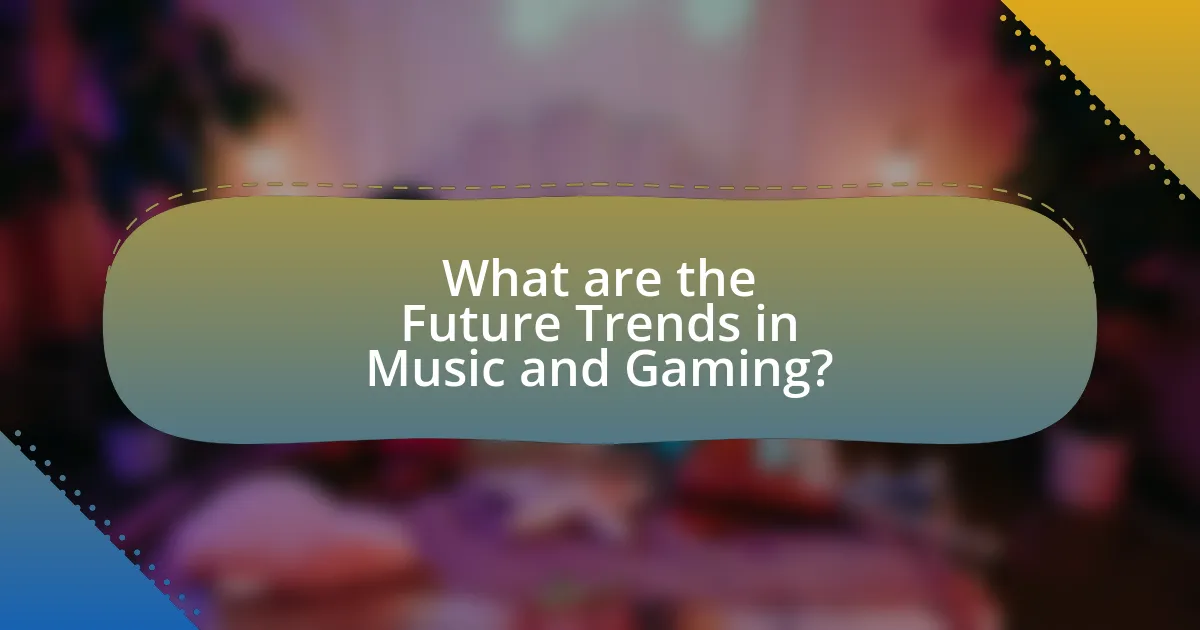
What are the Future Trends in Music and Gaming?
Future trends in music and gaming include the integration of interactive music experiences within gaming environments, the rise of virtual concerts, and the use of artificial intelligence for music composition. Interactive music experiences allow players to influence the soundtrack based on their actions, enhancing immersion. Virtual concerts, exemplified by events like Travis Scott’s Fortnite concert, demonstrate the potential for large-scale, interactive performances that blend gaming and live music. Additionally, AI-driven tools are increasingly being used to create personalized soundtracks and adaptive music that responds to gameplay, as seen in titles like “No Man’s Sky.” These trends indicate a growing synergy between music and gaming, driven by technological advancements and changing consumer preferences.
How is technology shaping the future of music in gaming?
Technology is shaping the future of music in gaming by enabling dynamic soundtracks and interactive audio experiences. Advances in artificial intelligence allow for adaptive music that responds to player actions, enhancing immersion and emotional engagement. For instance, games like “The Last of Us Part II” utilize procedural audio techniques, where music evolves based on gameplay, creating a unique experience for each player. Additionally, platforms like Spotify and Apple Music are integrating with gaming environments, allowing players to curate personalized soundtracks, further blurring the lines between gaming and music consumption. This integration not only enriches gameplay but also opens new avenues for artists to reach audiences within gaming contexts.
What innovations are emerging in music composition for games?
Innovations in music composition for games include adaptive music systems, AI-generated soundtracks, and interactive audio design. Adaptive music systems dynamically change the score based on player actions, enhancing immersion; for example, games like “The Last of Us Part II” utilize this technique to reflect emotional states and gameplay intensity. AI-generated soundtracks, such as those created by platforms like AIVA, allow for personalized music experiences tailored to individual player preferences, showcasing the potential of machine learning in composition. Additionally, interactive audio design, exemplified by the work of companies like Audiokinetic with their Wwise software, enables developers to create complex audio environments that respond to gameplay, further blurring the lines between music and interactive experiences. These innovations are reshaping how music is integrated into gaming, making it more responsive and engaging.
How might virtual reality and augmented reality change the music-gaming landscape?
Virtual reality (VR) and augmented reality (AR) are poised to significantly transform the music-gaming landscape by creating immersive experiences that blend interactive gameplay with musical elements. These technologies enable players to engage with music in a three-dimensional space, allowing for real-time interaction with sound and visuals, which enhances user engagement and emotional connection. For instance, VR platforms like Beat Saber allow players to physically interact with music by slicing through blocks in rhythm, demonstrating how immersive environments can elevate the gaming experience. Additionally, AR applications can overlay musical elements onto the real world, enabling users to experience live performances or music creation in their own environment, as seen in apps like Magic Piano. This integration of VR and AR into music gaming not only fosters creativity but also expands the potential for social interaction, as players can share experiences in virtual spaces, thus reshaping how music is consumed and enjoyed in gaming contexts.
What are the potential challenges facing the integration of music in gaming?
The potential challenges facing the integration of music in gaming include licensing issues, technical limitations, and player experience considerations. Licensing issues arise from the need to secure rights for music tracks, which can be complex and costly, especially for popular songs. Technical limitations refer to the constraints of game engines and platforms that may not support high-quality audio or dynamic music integration. Player experience considerations involve ensuring that music enhances gameplay without becoming distracting or repetitive, which requires careful design and testing. These challenges can significantly impact the effectiveness and enjoyment of music within gaming environments.
How do changing consumer preferences affect music choices in games?
Changing consumer preferences significantly influence music choices in games by driving developers to select tracks that resonate with current trends and player demographics. As players increasingly favor diverse genres and culturally relevant music, game developers adapt their soundtracks to enhance player engagement and emotional connection. For instance, the rise of hip-hop and electronic music in mainstream culture has led to their incorporation in popular games like “Fortnite,” which features tracks from contemporary artists to attract a younger audience. This alignment with consumer tastes not only boosts the game’s appeal but also reflects broader societal shifts in music consumption, as evidenced by the growing popularity of streaming platforms that prioritize user-curated playlists.
What are the implications of evolving copyright laws on music in gaming?
Evolving copyright laws significantly impact music in gaming by altering how developers can use and monetize music within their games. As copyright laws adapt to digital distribution and streaming, game developers face new challenges regarding licensing, ownership, and fair use. For instance, the introduction of the Music Modernization Act in the United States has streamlined licensing for digital music, which can benefit game developers by simplifying the process of obtaining rights for music tracks. However, stricter enforcement of copyright can also lead to increased costs and legal risks for developers who may inadvertently use unlicensed music. This dynamic creates a complex landscape where developers must navigate both the opportunities and challenges presented by changing copyright regulations to ensure compliance while enhancing the gaming experience with music.
What best practices can developers follow for integrating music into games?
Developers can follow several best practices for integrating music into games to enhance player experience and engagement. First, they should ensure that the music aligns with the game’s theme and atmosphere, as this creates an immersive environment that resonates with players. For instance, a horror game benefits from eerie soundscapes, while a fantasy game may use orchestral compositions to evoke a sense of adventure.
Additionally, developers should implement adaptive music systems that respond to gameplay dynamics, such as changing the music intensity during combat or transitioning to calmer melodies in exploration phases. This approach has been shown to increase player emotional engagement, as evidenced by studies indicating that dynamic soundtracks can significantly enhance the gaming experience.
Moreover, developers should consider the technical aspects of music integration, such as optimizing audio files for performance and ensuring compatibility across different platforms. Research indicates that poorly optimized audio can lead to lag and negatively impact gameplay, which underscores the importance of technical proficiency in music integration.
Finally, soliciting player feedback on music choices can provide valuable insights, allowing developers to refine their soundtracks based on player preferences and experiences. This practice not only improves the game’s audio quality but also fosters a community around the game, enhancing its overall success.
How can developers effectively collaborate with musicians and composers?
Developers can effectively collaborate with musicians and composers by establishing clear communication channels and defining project goals from the outset. This ensures that both parties understand the creative vision and technical requirements, facilitating a smoother workflow. Regular meetings and feedback sessions can help align musical elements with game mechanics, enhancing the overall experience. Additionally, utilizing collaborative tools such as shared platforms for file exchange and project management can streamline the process. Research indicates that successful collaborations often involve iterative feedback loops, allowing for adjustments based on gameplay testing and audience response, which ultimately leads to a more cohesive final product.
What strategies can enhance the overall impact of music in gaming experiences?
Incorporating adaptive music that responds to player actions can significantly enhance the overall impact of music in gaming experiences. This strategy allows the music to dynamically change based on gameplay, creating a more immersive environment. For instance, a study by the University of Southern California found that adaptive music increases player engagement and emotional response, leading to a more memorable gaming experience. Additionally, using thematic motifs that align with character development and narrative arcs can deepen emotional connections, as evidenced by the success of franchises like “The Legend of Zelda,” where music is intricately tied to storytelling.








